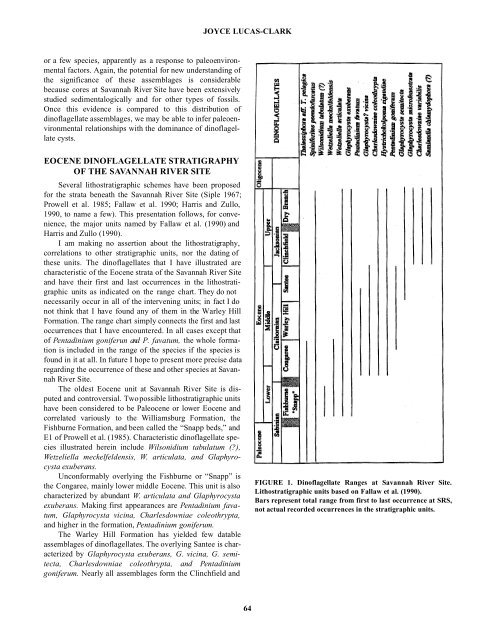Download Guidebook as .pdf (1.8 Mb) - Carolina Geological Society
Download Guidebook as .pdf (1.8 Mb) - Carolina Geological Society
Download Guidebook as .pdf (1.8 Mb) - Carolina Geological Society
You also want an ePaper? Increase the reach of your titles
YUMPU automatically turns print PDFs into web optimized ePapers that Google loves.
JOYCE LUCAS-CLARK<br />
or a few species, apparently <strong>as</strong> a response to paleoenvironmental<br />
factors. Again, the potential for new understanding of<br />
the significance of these <strong>as</strong>semblages is considerable<br />
because cores at Savannah River Site have been extensively<br />
studied sedimentalogically and for other types of fossils.<br />
Once this evidence is compared to this distribution of<br />
dinoflagellate <strong>as</strong>semblages, we may be able to infer paleoenvironmental<br />
relationships with the dominance of dinoflagellate<br />
cysts.<br />
EOCENE DINOFLAGELLATE STRATIGRAPHY<br />
OF THE SAVANNAH RIVER SITE<br />
Several lithostratigraphic schemes have been proposed<br />
for the strata beneath the Savannah River Site (Siple 1967;<br />
Prowell et al. 1985; Fallaw et al. 1990; Harris and Zullo,<br />
1990, to name a few). This presentation follows, for convenience,<br />
the major units named by Fallaw et al. (1990) and<br />
Harris and Zullo (1990).<br />
I am making no <strong>as</strong>sertion about the lithostratigraphy,<br />
correlations to other stratigraphic units, nor the dating of<br />
these units. The dinoflagellates that I have illustrated are<br />
characteristic of the Eocene strata of the Savannah River Site<br />
and have their first and l<strong>as</strong>t occurrences in the lithostratigraphic<br />
units <strong>as</strong> indicated on the range chart. They do not<br />
necessarily occur in all of the intervening units; in fact I do<br />
not think that I have found any of them in the Warley Hill<br />
Formation. The range chart simply connects the first and l<strong>as</strong>t<br />
occurrences that I have encountered. In all c<strong>as</strong>es except that<br />
of Pentadinium goniferun and P. favatum, the whole formation<br />
is included in the range of the species if the species is<br />
found in it at all. In future I hope to present more precise data<br />
regarding the occurrence of these and other species at Savannah<br />
River Site.<br />
The oldest Eocene unit at Savannah River Site is disputed<br />
and controversial. Two possible lithostratigraphic units<br />
have been considered to be Paleocene or lower Eocene and<br />
correlated variously to the Williamsburg Formation, the<br />
Fishburne Formation, and been called the “Snapp beds,” and<br />
E1 of Prowell et al. (1985). Characteristic dinoflagellate species<br />
illustrated herein include Wilsonidium tabulatum (),<br />
Wetzeliella meckelfeldensis, W. articulata, and Glaphyrocysta<br />
exuberans.<br />
Unconformably overlying the Fishburne or “Snapp” is<br />
the Congaree, mainly lower middle Eocene. This unit is also<br />
characterized by abundant W. articulata and Glaphyrocysta<br />
exuberans. Making first appearances are Pentadinium favatum,<br />
Glaphyrocysta vicina, Charlesdowniae coleothrypta,<br />
and higher in the formation, Pentadinium goniferum.<br />
The Warley Hill Formation h<strong>as</strong> yielded few datable<br />
<strong>as</strong>semblages of dinoflagellates. The overlying Santee is characterized<br />
by Glaphyrocysta exuberans, G. vicina, G. semitecta,<br />
Charlesdowniae coleothrypta, and Pentadinium<br />
goniferum. Nearly all <strong>as</strong>semblages form the Clinchfield and<br />
FIGURE 1. Dinoflagellate Ranges at Savannah River Site.<br />
Lithostratigraphic units b<strong>as</strong>ed on Fallaw et al. (1990).<br />
Bars represent total range from first to l<strong>as</strong>t occurrence at SRS,<br />
not actual recorded occurrences in the stratigraphic units.<br />
64













